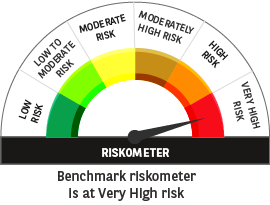AUM
₹ 725.38 Crores
Benchmark
Nifty Energy TRI
Inception Date
10-02-2025
Expense Ratio (Base)
2.17%
As on 02-01-2026
Bars show Return distribution (% of times) in a given range for a selected time period.

Last 6 months |
1 year |
3 years |
5 years |
Since inception |
|
|---|---|---|---|---|---|
| Regular Plan (% CAGR*) | 3.25% | N.A. | N.A. | N.A. | 18.52% |
| Direct Plan (% CAGR*) | 4.88% | N.A. | N.A. | N.A. | 20.38% |
| Nifty Energy TRI (% CAGR*) | -0.22% | N.A. | N.A. | N.A. | 14.71% |
| Additional Benchmark Nifty 50 TRI (% CAGR*) | 13.41% | N.A. | N.A. | N.A. | 16.63% |
| Value of ₹10,000 Invested In | Last 6 months |
1 year |
3 years |
5 years |
Since inception |
|---|---|---|---|---|---|
| Regular Plan | 10161.85 | N.A | N.A | N.A | 11451.04 |
| Direct Plan | 10243.29 | N.A | N.A | N.A | 11593.61 |
| Nifty Energy TRI | 9988.84 | N.A | N.A | N.A | 11156.37 |
| Additional Benchmark Nifty 50 TRI | 10668.45 | N.A | N.A | N.A | 11305.05 |
Past performance may or may not be sustained in future and is not a guarantee of any future returns. Returns do not take into account the load, if any. Returns are for growth option. Different plans shall have a different expense structure. The performance details provided above are for regular/distributor plan.
Please refer below for fund manager details and performance of other funds managed by the Fund Manager(s)
*Compound annual growth rate
**Benchmark & ***Additional Benchmark
Data As on 30th November 2025 or specified otherwise.

This calculator is provided for informational purposes only.
The results are based on user inputs and should not be considered as investment advice. Users should seek the advice of a qualified financial professional before making any investment decisions.
The creators of the calculator and its affiliates shall not be held responsible for any financial losses resulting from the use of the calculator.
Past performance may or may not be sustained in the future and should not be used as a basis for comparison with other investments. Mutual Fund Investments are subject to market risks, read all scheme related documents carefully.
SIP is allowed in select open ended schemes. Refer the Scheme SAI, SID, KIM for detailed information


Fund BARODA BNP PARIBAS ELSS Tax Saver Fund - Regular - Growth Option
Frequency Monthly
SIP Start Date 05-01-2006
SIP End Date 01-01-2025
Invested Amount ₹22,80,000.00
Current Value ₹1,03,86,141.98
Scheme Returns 14.17%
Benchmark Returns 14.12%
TER (Total Expense Ratio) 2.2%
This calculator is provided for informational purposes only.
The results are based on user inputs and should not be considered as investment advice. Users should seek the advice of a qualified financial professional before making any investment decisions.
The creators of the calculator and its affiliates shall not be held responsible for any financial losses resulting from the use of the calculator.
Past performance may or may not be sustained in the future and should not be used as a basis for comparison with other investments. Mutual Fund Investments are subject to market risks, read all scheme related documents carefully.
SIP is allowed in select open ended schemes. Refer the Scheme SAI, SID, KIM for detailed information
The investment objective of the Scheme is to provide investors with opportunities for long term capital appreciation by investing in equity and equity related instruments of companies engaging in activities such as exploration, roduction, distribution, transportation and processing of traditional & new energy including but not limited to industries/sectors such as oil & gas, utilities and power. The Scheme does not guarantee/indicate any returns. There can be no assurance that the scheme's objectives will be achieved.
Entry Load : Not applicable
Exit Load:
· If units of the Scheme are redeemed or switched out within 1 year from the date of allotment: 1%.
· If units of the Scheme are redeemed or switched out after 1 year from the date of allotment: Nil.
Lumpsum Details:
Minimum Application Amount: ₹1,000 and in multiples of ₹1 thereafter.
Minimum Additional Application Amount: ₹1,000 and in multiple of ₹1 thereafter
(i) Daily, Weekly, Monthly SIP: ₹ 500/- and in multiples of ₹ 1/- thereafter;
(ii) Quarterly SIP: ₹ 1500/- and in multiples of ₹ 1/- thereafter. There is no upper limit for application.
₹ 1,000/- and in multiples of Re. 1/- thereafter per installment, where an investor opts for a Daily/ weekly/ fortnightly/ monthly STP. ₹ 1,500/- and in multiples of Re. 1/- thereafter per installment, where an investor opts for a quarterly STP. STP will be terminated if the amount to be transferred is less than the minimum application amount of the transferee scheme.
₹ 1,000/- and in multiples of Re. 1/- thereafter per installment, where an investor opts for a weekly/ monthly SWP ₹ 1,500/- and in multiples of Re. 1/- thereafter per installment, where an investor opts for a quarterly SWP
An open-ended equity scheme investing in energy companies.
This product is suitable for investors who are seeking*:
- Long term capital creation.
- Investment predominantly in equity & equity related instruments of energy companies.


^^Riskometer For Scheme: basis it's portfolio, ^Riskometer For Benchmark (Nifty Energy TRI): basis it's constituents; as on November 30, 2025
*Investors should consult their financial advisers if in doubt about whether the product is suitable for them.

Sanjay Chawla
Chief Investment Officer Equity (CIO-Equity)
Managing this fund since November 2025
Performance of Other Funds Managed by Sanjay Chawla
Kirtan Mehta
Senior Analyst
Managing this fund since February 2025
Performance of Other Funds Managed by Kirtan Mehta
An open-ended equity scheme investing in energy companies.
Thematic
₹ 11.7298
NAV as on 02-01-2026

18.52 %
Returns lumpsum
| Schemes (Benchmark Index) | 1 Year CAGR | 3 Year CAGR | 5 Year CAGR | |||
|---|---|---|---|---|---|---|
| Scheme Returns | Benchmark Returns | Scheme Returns | Benchmark Returns | Scheme Returns | Benchmark Returns | |
| Baroda BNP Paribas Balanced Advantage Fund (NIFTY 50 Hybrid Composite Debt 50:50 Index) | 7.65% | 14.15% | 13.98% | 8.39% | 13.32% | 10.41% |
| Baroda BNP Paribas Banking and Financial Services Fund (Nifty Financial Service TRI) | 14.04% | 12.79% | 16.23% | 17.36% | 15.64% | 14.08% |
| Baroda BNP Paribas ELSS Tax Saver Fund (Nifty 500 TRI) | 5.59% | 11.96% | 18.71% | 6.58% | 17.96% | 15.61% |
| Baroda BNP Paribas Flexi Cap Fund (Nity 500 Total Return Index) | 2.66% | 15.38% | 15.64% | 6.58% | N.A.* | 15.61% |
| Baroda BNP Paribas Focused Fund (Nifty 500 TRI) | 2.43% | 10.52% | 13.90% | 6.58% | 15.42% | 15.61% |
| Baroda BNP Paribas Large and Mid Cap Fund (BSE 250 Large & Midcap TRI) | 0.86% | 21.53% | 17.72% | 7.55% | 20.08% | 14.95% |
| Baroda BNP Paribas Multi Cap Fund (Nifty 500 Multicap 50:25:25 TRI) | 0.02% | 15.28% | 18.40% | 4.78% | 20.83% | 17.99% |
| Baroda BNP Paribas Small Cap Fund (Nifty Small Cap 250 TRI ) | -4.04% | 13.19% | N.A.* | -5.03% | N.A.* | N.A.* |
Period for which scheme's performance has been provided is computed basis last day of the month-end preceding the date of advertisement.
Past performance may or may not be sustained in future and should not be used as a basis of comparison with other investments. Returns do not take into account the load, if any. Returns are for growth option. Different plans shall have a different expense structure. The performance details provided above are for regular/distributor plan.
For Fund Manager(s) & Managing Since Details click here
*Where returns are not available for that particular period, they have not been shown.
| Schemes (Benchmark Index) | 1 Year CAGR | 3 Year CAGR | 5 Year CAGR | |||
|---|---|---|---|---|---|---|
| Scheme Returns | Benchmark Returns | Scheme Returns | Benchmark Returns | Scheme Returns | Benchmark Returns | |
| Baroda BNP Paribas Flexi Cap Fund (Nity 500 Total Return Index) | 2.66% | 15.38% | 15.64% | 6.58% | N.A.* | 15.61% |
| Baroda BNP Paribas Focused Fund (Nifty 500 TRI) | 2.43% | 10.52% | 13.90% | 6.58% | 15.42% | 15.61% |
| Baroda BNP Paribas Large and Mid Cap Fund (BSE 250 Large & Midcap TRI) | 0.86% | 21.53% | 17.72% | 7.55% | 20.08% | 14.95% |
| Baroda BNP Paribas Multi Cap Fund (Nifty 500 Multicap 50:25:25 TRI) | 0.02% | 15.28% | 18.40% | 4.78% | 20.83% | 17.99% |
Period for which scheme's performance has been provided is computed basis last day of the month-end preceding the date of advertisement.
Past performance may or may not be sustained in future and should not be used as a basis of comparison with other investments. Returns do not take into account the load, if any. Returns are for growth option. Different plans shall have a different expense structure. The performance details provided above are for regular/distributor plan.
For Fund Manager(s) & Managing Since Details click here
*Where returns are not available for that particular period, they have not been shown.